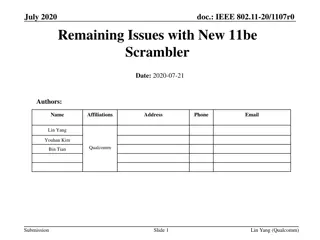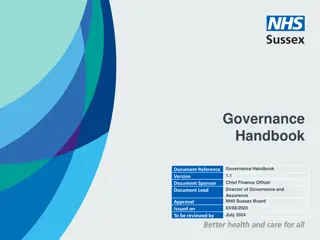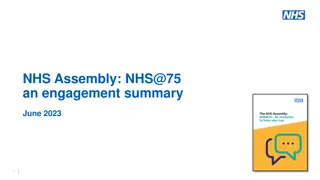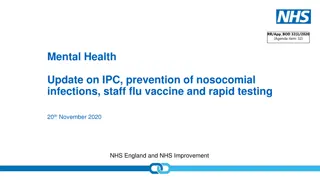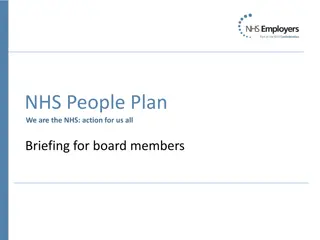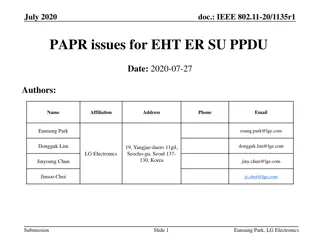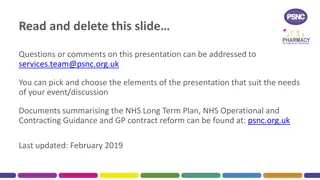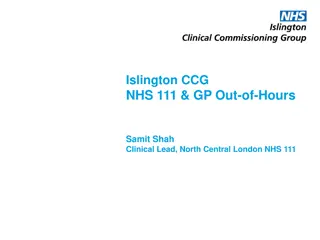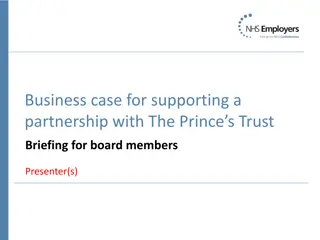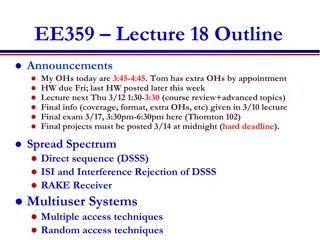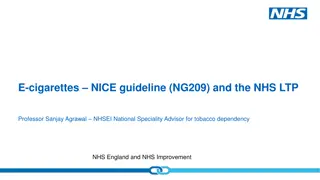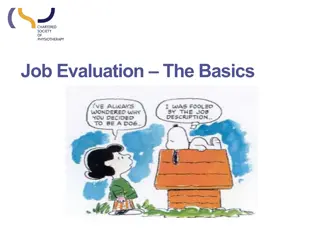PAPR Training with Drager X-plore 8000 - NHS Guidance
Issued with a Powered Air Purifying Respirator (PAPR) due to fit testing issues or mask shortages? This training covers using the Drager X-plore 8000, including setup, operation, and maintenance. Achieve competence, watch instructional videos, and follow safety protocols for proper PAPR use. Ensure battery readiness and learn about essential components for effective PAPR operation. Take steps towards certification with hands-on practice and assessment by your local trainer.
Download Presentation

Please find below an Image/Link to download the presentation.
The content on the website is provided AS IS for your information and personal use only. It may not be sold, licensed, or shared on other websites without obtaining consent from the author.If you encounter any issues during the download, it is possible that the publisher has removed the file from their server.
You are allowed to download the files provided on this website for personal or commercial use, subject to the condition that they are used lawfully. All files are the property of their respective owners.
The content on the website is provided AS IS for your information and personal use only. It may not be sold, licensed, or shared on other websites without obtaining consent from the author.
E N D
Presentation Transcript
PAPR Training PAPR Training Drager, X-plore 8000 Version 1, 22/1/21 NHS Greater Glasgow & Clyde
Introduction Introduction You are being issued with PAPR because fit testing to the range of FFP3 disposable masks has been unsuccessful or the mask you have fit tested to is in short supply. The Hood is yours, the rest may be shared between users It works through positive filtered air flow. Filtered air flows in the back of the hood, over your head and face, and out. This air flow prevents contaminated air from entering the hood. A tight fit is not required.
Achieving Competence 1. Read through this presentation, accessing any links to additional learning materials and read / watch them. 2. Unpack the PAPR Drager component parts and practice putting them together and taking them apart. 3. Practice donning and doffing the PAPR unit and wearing the hood whilst it is operating. Any questions please contact your local PAPR trainer. 4. Work through the Infection, Prevention and Control doffing and decontamination procedures and how they will apply in your work space. Speak to your line manager if this is not clear. 5. Undertake self check of knowledge and competence. 6. Arrange to be assessed by your local PAPR Trainer.
Drager 8000 Series Please watch the video at the link below: https://www.youtube.com/watch?v=HjfxJ2ewK0I Whilst not all of the components of the video will be relevant, it will give you an overview of the system you will be using which will help with the following slides. Please follow the instruction on the slides.
How to use the How to use the Drager Drager X X- -Plore Plore 8000 PAPR 8000 PAPR Please unpack and lay out in fron of you all of the component parts: Long life battery Battery charger Blower Unit P3 Filter Decontamination Belt Hose Short Hood
Battery Battery Long life battery Minimum of 8 hours at full power, up to 20 hours at lowest power Must be full charge before use (Check on battery and Blower) Battery life charge - 4 segments >75% - 3 segments >50% - 2 segments > 25% - 1 segments 25% Hook in and click to the Blower After use, always recharge the battery to full before putting in the box. NB Your service may prefer to keep it on charge all the time, which it is perfectly safe to do.
Battery Charger Battery Charger Battery charger First time out of the box you will need to assemble the charger. It comes with various plugs for different countries. Assemble using the three pronged option, it will look like a standard british plug. Can take 4 hours to fully charge from low charge Status indicator Green = charged / flashing green = being charged / flashing yellow = charging interrupted
Filter Filter P3 Filter Check shelf life expiry date on first opening this is written on the filter edge Over write this date with date 1 Calendar month in advance Check the filter says P3 along the filter edge near to the expiry date Update filter change record form Check rubber seal for damage
Filter ( Filter (Cont Cont/d) /d) P3 Filter Insert into grey splashguard Insert at angle into Blower unit, ensure audible click is heard Check filter splashguard securely fitted on all sides Do not reopen the filter until it is time to dispose of it check the filter change form for the expiry date. Take IPC precautions prior to opening. Residual filter capacity - 4 segments >75% - 3 segments >50% - 2 segments > 25% - 1 segments 25%
Belt and Hose Belt and Hose Decontamination Belt Size it before attaching to Blower It has a top and bottom Hook in and click to Blower Hose Both ends the same, they will push and click into the hood and blower Check black O rings are present in both ends if missing do not use When decontaminating after use, ensure you clean all the way along the surface
Blower Unit Blower Unit Blower Unit 3 Fan speeds, when you start it up and it is connected to the hood, it will automatically start in the lowest fan setting. It is unlikely you will need to increase the fan speed, doing so will reduce the period the battery will operate for Battery alerts a low battery will trigger an audible, visual and vibrating alert. A yellow light = < 30mins, a red light = < 10 mins. Filter alerts an audible, visual and vibrating alert will trigger if the filter becomes clogged, a yellow light = <20%, a red light = <10%.
Blower Unit ( Blower Unit (Cont Cont/d) /d) Blower Unit Test the alerts prior to use by: Connect up everything except hood start up wait for self diagnostic to complete Cover end of hose it will vibrate, sound and flash
Hood Hood Short Hood This is yours 1st time, adjust fit if required using one or both of the plastic cradle straps, pull to tighten and squeeze middle to slacken Every time, examine condition prior to donning Attach hose and start the Blower Holding the 2 loops at front / bottom of hood, take to back of head and pull down over the face and under chin When removing, use the same 2 loops, pulling down, away from your face, up and to the side Then switch off Blower
Pre Pre- -operation checklist operation checklist Ensure battery is fitted securely Filter splashguard is fitted securely Hose is securely connected to the head top and blower unit Finally visually inspect the head top/hose for any rip/tears
Switching on the device Switching on the device Press the green power button, device will perform a self test Indicator light will light up green if the device is working properly If a warning indicator signals, the fault must be rectified before use (refer to instruction for use manual) Power unit will automatically detect what headpiece is being used and will set the minimum flow rate for that headpiece Flow rate can be adjusted using the + or button on top of the control panel (3 flow levels), unlikely to require more than the low flow rate
Drager 8000 Series A Quick Guide can be found at the link below: https://www.nhsggc.org.uk/media/263588/drager-x-plore-8000-quick-guide.pdf The instructions for use can be found at the link below: https://www.nhsggc.org.uk/media/263584/papr-ifu-drager-x-plore-8000.pdf
Have a Practice Ask your local PAPR Trainer any questions
Checks Checks All checks need to be linked to the Blower serial number Store the PAPR in a box which is clearly labelled with the blower serial number, with the following: Pre-use check - User Monthly checks (when not used) - User Annual check - TBC Filter Change Form - record expiry date, 1 calendar month after opening Above documentation and guidance, including the Step by Step Guide can be found here. https://www.nhsggc.org.uk/working-with-us/hr-connect/health-safety/policies-guidance-documents-forms/personal-protective-equipment/powered-air-purifying-respirators-papr/
The process for doffing and decontaminating the Drager PAPR system Infection Prevention and Control Team NHS GGC
PAPR and You PAPR and You The hood must only be used by you but the power unit / filter and hose can be used by more than one person provided it is decontaminated thoroughly after each use and before being stored. You must only use this PAPR when clinical care requires you to undertake an aerosol generating procedure (AGP) The PAPR Blower unit and hose should be worn under your disposable fluid resistant gown. Therefore the hood and the top of the hose are the only parts exposed. This learning assumes you are knowledgeable and competent at undertaking the 6 steps of hand hygiene as per the National Infection Prevention and Control Manual
Preparing to put the PAPR system on Preparing to put the PAPR system on Donning the breathing system must only be undertaken in a designated area of the clinical department. This may require a buddy to help you Hair, where required, should be tied back prior to donning the hood. A surgical hat may help Undertake hand hygiene prior to donning Follow manufacturer s instructions to don the complete system. Once on, check that breathing is not impaired. If difficulty is experienced this may indicate that the filter must be changed. The filter should be discarded and a fresh one applied every calendar month (you need to keep a record with the PAPR of filter changes)
A note about filters A note about filters If you are using the filter for the first time, ensure you: Check filter is within usage date Write the new expiration date over the date New expiration date = date of inserting filter + 1 month: - opened 30/10/20, write: Exp 30/11/20 Filters need to be changed : - every calendar month - If they get wet - if the wearer feels it has become harder to breath through the filter.
Doffing and decontamination Doffing and decontamination Do not switch off the respirator until you have left the AGP hot spot . Do not remove the hood until you have left the AGP hot spot Only doff and decontaminate the PAPR in the designated doffing / decontamination area in your department Once in designated doffing clinical area, follow the doffing procedure (poster) to ensure you remove the system safely Follow the decontamination instructions fully prior to storing in the designated location
Doffing Doffing the PAPR the PAPR 1. The HCW must not remove the hood or switch off the PAPR unit until out of the AGP area On leaving the AGP area, the HCW must immediately go to the designated doffing / decontamination area. 2. 3. The HCW will remove their gloves then gown, discard in clinical waste bin and undertake hand hygiene using ABHR and put on a fresh pair of gloves. 4. The HCW will clean the visor section of the hood with a Clinell (Green) wipe and discard the wipe into a clinical waste bin. Remove gloves and use ABHR. 5. The HCW will remove the hood using loops under chin and by pulling away from the face carefully and place in the designated cleaning area.
Doffing Doffing the PAPR the PAPR (Cont/d) 6. The HCW will switch off the PAPR unit. 7. The HCW will disconnect the hose from the hood. 8. The HCW will unclip the belt and place unit and belt with the hose still connected, on to the designated cleaning area. 9. The HCW will undertake hand hygiene with ABHR and apply an FRSM. 10. The HCW will then follow the instructions for cleaning the PAPR unit and system.
Decontamination Decontamination The HCW cleaning the PAPR system must only do so in the designated cleaning area. Either the Green Clinell Universal Disinfectant Wipes OR Actichlor Plus must be used. If there is a large amount of blood on the hood, please discard. Small splashes of blood: use a 10,000 ppm solution of Actichlor Plus to decontaminate the hood. The contact time for Actichlor Plus is 5 minutes. Actichlor Plus should be wiped off using either the yellow or Green Clinell wipes. The HCW must be wearing a clean apron, gloves, FRSM and visor to undertake the following procedures.
Decontamination Decontamination (Cont/d) 1. To clean the hose: Disconnect the hose and inspect hose connections for dirt/debris and then clean ensuring that each of the grooves the entire length of the hose are cleaned thoroughly. Discard the wipe. Set aside the hose in a clean area to dry. 2. To clean the PAPR unit: Inspect the unit for dirt / debris. Clean the casing of the unit with disinfectant wipes. It is not necessary to remove the casing covering the filter. It is important not to allow water to drip into the filter unit. Set aside in a clean area to dry. 3. The hood: Clean the external surfaces of the hood with a disinfectant wipes. With a fresh wipe you may want to give the inside of the hood a wipe also. Set aside in a clean area to dry. This hood belongs to a named HCW and must be returned to them, not shared with anyone else and be carefully stored once clean and dry, until next use. It is the responsibility of the named HCW to ensure this happens.
Decontamination Decontamination (Cont/d) 4. The PAPR unit and hose: Once dry, check if the battery needs to be charged should be at full charge. If it does not need charged, the PAPR and hose will be place in the designated storage box labelled for that unit Check PAPR unit Serial Numbers match. 5. Filter care: At point of putting on the PAPR unit, the HCW must check the expiry date for the filter, located on a record sheet in the PAPR s storage box. If 30 calendar days have passed, the filter must be changed following manufacturer s instructions. A disposable apron, gloves and FRSM must be worn when changing the filter
Workplace preparation Workplace preparation Speak with your line manager with regards: Checking the doffing / decontamination area is suitable for your needs Identifying how and where the PAPR is going to be stored Where the battery will be charged Process for getting new filters
Next Steps Next Steps Once you feel confident you know how to use the PAPR system, undertake the self assessment to check your knowledge and competence to use the PAPR unit - any questions please contact your local PAPR Trainer Once you have completed the above, contact your PAPR Trainer to arrange for a competency assessment (remember to take your completed Self Assessment form) Once you are: confident you can use the PAPR system safely, and have been assessed by the local PAPR Trainer as competent notify your line manager that you are able to use it for AGP activities and provide them with your completed and signed competency assessment form







